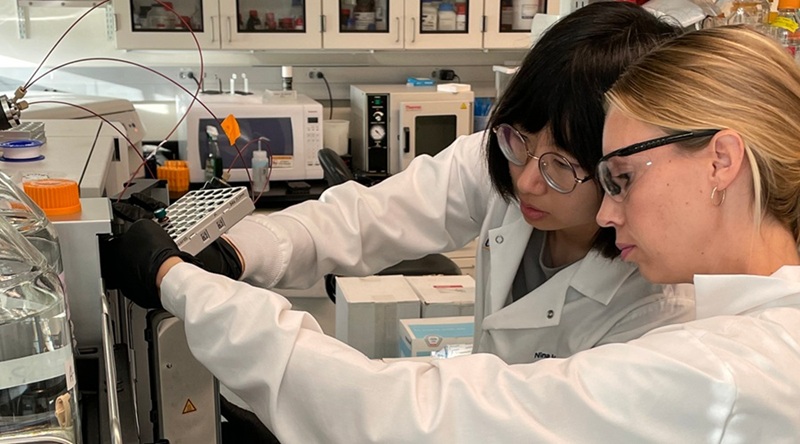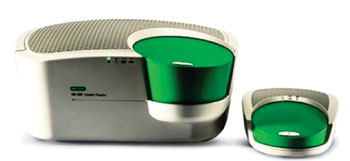Molecular Urine Test Identifies Lung Carcinoma Mutations
|
By LabMedica International staff writers Posted on 20 May 2015 |
The monitoring of circulating tumor DNA (ctDNA) is a promising technique that may provide clinicians with a faster, cheaper and less invasive way to evaluate the clinical status and response to therapy of cancer patients.
Disease progression in patients with metastatic non-small-cell lung cancer (NSCLC) is often heralded by the acquisition of epidermal growth factor receptor (EGFR) T790M resistance mutation following treatment with anti-EGFR inhibitors.
Scientists at Moores Cancer Center (La Jolla, CA, USA) took urine samples from patients with metastatic NSCLC who progressed on erlotinib treatment and ctDNA was extracted by a method that preferentially isolates short, fragmented ctDNA. Droplet digital polymerase chain reaction system (Bio-Rad; Hercules, CA, USA) was used to quantify the ctDNA and yielded an average of total amplifiable ctDNA per sample of 0.4 µg (range, 0.04 µg to 2.4 µg). Spiked cell lines were used for analytical characterization and demonstrated that the EGFR T790M assay had a lower limit of detection of two copies within a background of 60 ng of wild-type DNA, yielding an analytical sensitivity of 0.01%. EGFR status was analyzed using a PCR method that amplifies short target DNA fragments using kinetically-favorable binding conditions for a wild type blocking oligonucleotide, followed by massively parallel deep sequencing using a MiSeq desktop sequencer (Illumina; San Diego CA, USA).
EGFR T790M mutation in urine was detected in 15 of 22 (68%) of patients receiving anti-EGFR treatment until progression. Urine EGFR T790M mutation was detected in 10 out of 10 tissue-positive patients, giving 100% concordance. Urine ctDNA testing identified five additional patients who may be eligible for treatment with anti-T790M drugs, three of whom were tissue negative. The investigators showed that EGFR T790M mutation can be detected in urinary ctDNA up to three months before radiographic progression on first-line anti-EGFR tyrosine kinase inhibitor (TKI). When T790M positive patients were treated with third generation anti-EGFR TKIs, a decrease in ctDNA T790M load was observed as early as four hours after therapy on first day of treatment. The initial decrease in urinary T790M was followed by a spike in T790M during the first week of therapy.
Hatim Husain, MD, the lead author of the study and his colleagues concluded that this ctDNA assay for multiple genes via next-generation sequencing (NGS) might become a "liquid biopsy" that could serve as an alternative to invasive tissue biopsy. EGFR T790M mutation in urine was detected months before radiographic detection, and furthermore, urine ctDNA testing identified tissue negative patients who may be eligible for treatment with third generation anti-EGFR TKIs and monitoring of urinary T790M dynamics may predict clinical benefit or initial tumour burden. The study was presented at the EUROPEAN Lung Cancer Conference held April 15–18, 2015, in Geneva (Switzerland).
Related Links:
Moores Cancer Center
Bio-Rad
Illumina
Disease progression in patients with metastatic non-small-cell lung cancer (NSCLC) is often heralded by the acquisition of epidermal growth factor receptor (EGFR) T790M resistance mutation following treatment with anti-EGFR inhibitors.
Scientists at Moores Cancer Center (La Jolla, CA, USA) took urine samples from patients with metastatic NSCLC who progressed on erlotinib treatment and ctDNA was extracted by a method that preferentially isolates short, fragmented ctDNA. Droplet digital polymerase chain reaction system (Bio-Rad; Hercules, CA, USA) was used to quantify the ctDNA and yielded an average of total amplifiable ctDNA per sample of 0.4 µg (range, 0.04 µg to 2.4 µg). Spiked cell lines were used for analytical characterization and demonstrated that the EGFR T790M assay had a lower limit of detection of two copies within a background of 60 ng of wild-type DNA, yielding an analytical sensitivity of 0.01%. EGFR status was analyzed using a PCR method that amplifies short target DNA fragments using kinetically-favorable binding conditions for a wild type blocking oligonucleotide, followed by massively parallel deep sequencing using a MiSeq desktop sequencer (Illumina; San Diego CA, USA).
EGFR T790M mutation in urine was detected in 15 of 22 (68%) of patients receiving anti-EGFR treatment until progression. Urine EGFR T790M mutation was detected in 10 out of 10 tissue-positive patients, giving 100% concordance. Urine ctDNA testing identified five additional patients who may be eligible for treatment with anti-T790M drugs, three of whom were tissue negative. The investigators showed that EGFR T790M mutation can be detected in urinary ctDNA up to three months before radiographic progression on first-line anti-EGFR tyrosine kinase inhibitor (TKI). When T790M positive patients were treated with third generation anti-EGFR TKIs, a decrease in ctDNA T790M load was observed as early as four hours after therapy on first day of treatment. The initial decrease in urinary T790M was followed by a spike in T790M during the first week of therapy.
Hatim Husain, MD, the lead author of the study and his colleagues concluded that this ctDNA assay for multiple genes via next-generation sequencing (NGS) might become a "liquid biopsy" that could serve as an alternative to invasive tissue biopsy. EGFR T790M mutation in urine was detected months before radiographic detection, and furthermore, urine ctDNA testing identified tissue negative patients who may be eligible for treatment with third generation anti-EGFR TKIs and monitoring of urinary T790M dynamics may predict clinical benefit or initial tumour burden. The study was presented at the EUROPEAN Lung Cancer Conference held April 15–18, 2015, in Geneva (Switzerland).
Related Links:
Moores Cancer Center
Bio-Rad
Illumina
Read the full article by registering today, it's FREE! 

Register now for FREE to LabMedica.com and get access to news and events that shape the world of Clinical Laboratory Medicine. 
- Free digital version edition of LabMedica International sent by email on regular basis
- Free print version of LabMedica International magazine (available only outside USA and Canada).
- Free and unlimited access to back issues of LabMedica International in digital format
- Free LabMedica International Newsletter sent every week containing the latest news
- Free breaking news sent via email
- Free access to Events Calendar
- Free access to LinkXpress new product services
- REGISTRATION IS FREE AND EASY!
Sign in: Registered website members
Sign in: Registered magazine subscribers
Latest Pathology News
- Rapid Low-Cost Tests Can Prevent Child Deaths from Contaminated Medicinal Syrups
- Tumor Signals in Saliva and Blood Enable Non-Invasive Monitoring of Head and Neck Cancer
- Common Health Issues Can Influence New Blood Tests for Alzheimer’s Disease
- Blood Test Formula Identifies Chronic Liver Disease Patients with Higher Cancer Risk
- Tunable Cell-Sorting Device Holds Potential for Multiple Biomedical Applications
- AI Tool Outperforms Doctors in Spotting Blood Cell Abnormalities
- AI Tool Rapidly Analyzes Complex Cancer Images for Personalized Treatment
- Diagnostic Technology Performs Rapid Biofluid Analysis Using Single Droplet
- Novel Technology Tracks Hidden Cancer Cells Faster
- AI Tool Improves Breast Cancer Detection
- AI Tool Predicts Treatment Success in Rectal Cancer Patients
- Blood Test and Sputum Analysis Predict Acute COPD Exacerbation
- AI Tool to Transform Skin Cancer Detection with Near-Perfect Accuracy
- Unique Immune Signatures Distinguish Rare Autoimmune Condition from Multiple Sclerosis
- Simple Optical Microscopy Method Reveals Hidden Structures in Remarkable Detail
- Hydrogel-Based Technology Isolates Extracellular Vesicles for Early Disease Diagnosis
Channels
Clinical Chemistry
view channel
Online Tool Detects Drug Exposure Directly from Patient Samples
Doctors often rely on patient interviews and medical records to determine what medications a person has taken, but this information is frequently incomplete. People may forget drugs they used, take over-the-counter... Read more
Chemical Imaging Probe Could Track and Treat Prostate Cancer
Prostate cancer remains a leading cause of illness and death among men, with many patients eventually developing resistance to standard hormone-blocking therapies. These drugs often lose effectiveness... Read moreMolecular Diagnostics
view channel
New 15-Minute Hepatitis C Test Paves Way for Same-Day Treatment
Chronic hepatitis C infection affects an estimated 50 million people worldwide and causes around 242,000 deaths each year, largely due to cirrhosis and liver cancer. Although the infection is curable with... Read more
Ovarian Cancer Assay Outperforms Traditional Tests in Early Disease Detection
Globally, ovarian cancer is one of the deadliest cancers affecting women. Traditionally, early diagnosis of ovarian cancer has been challenging. Many ovarian cancers are diagnosed only after they have... Read moreHematology
view channel
MRD Tests Could Predict Survival in Leukemia Patients
Acute myeloid leukemia is an aggressive blood cancer that disrupts normal blood cell production and often relapses even after intensive treatment. Clinicians currently lack early, reliable markers to predict... Read more
Platelet Activity Blood Test in Middle Age Could Identify Early Alzheimer’s Risk
Early detection of Alzheimer’s disease remains one of the biggest unmet needs in neurology, particularly because the biological changes underlying the disorder begin decades before memory symptoms appear.... Read more
Microvesicles Measurement Could Detect Vascular Injury in Sickle Cell Disease Patients
Assessing disease severity in sickle cell disease (SCD) remains challenging, especially when trying to predict hemolysis, vascular injury, and risk of complications such as vaso-occlusive crises.... Read more
ADLM’s New Coagulation Testing Guidance to Improve Care for Patients on Blood Thinners
Direct oral anticoagulants (DOACs) are one of the most common types of blood thinners. Patients take them to prevent a host of complications that could arise from blood clotting, including stroke, deep... Read moreImmunology
view channel
Routine Blood Test Can Predict Who Benefits Most from CAR T-Cell Therapy
CAR T-cell therapy has transformed treatment for patients with relapsed or treatment-resistant non-Hodgkin lymphoma, but many patients eventually relapse despite an initial response. Clinicians currently... Read more
New Test Distinguishes Vaccine-Induced False Positives from Active HIV Infection
Since HIV was identified in 1983, more than 91 million people have contracted the virus, and over 44 million have died from related causes. Today, nearly 40 million individuals worldwide live with HIV-1,... Read more
Gene Signature Test Predicts Response to Key Breast Cancer Treatment
DK4/6 inhibitors paired with hormone therapy have become a cornerstone treatment for advanced HR+/HER2– breast cancer, slowing tumor growth by blocking key proteins that drive cell division.... Read more
Chip Captures Cancer Cells from Blood to Help Select Right Breast Cancer Treatment
Ductal carcinoma in situ (DCIS) accounts for about a quarter of all breast cancer cases and generally carries a good prognosis. This non-invasive form of the disease may or may not become life-threatening.... Read moreMicrobiology
view channel
Blood-Based Diagnostic Method Could Identify Pediatric LRTIs
Lower-respiratory tract infections (LRTIs) are a leading cause of illness and death worldwide, and pneumonia is the leading infectious cause of death in children under five, claiming the lives of over... Read more
Rapid Diagnostic Test Matches Gold Standard for Sepsis Detection
Sepsis kills 11 million people worldwide every year and generates massive healthcare costs. In the USA and Europe alone, sepsis accounts for USD 100 billion in annual hospitalization expenses.... Read moreRapid POC Tuberculosis Test Provides Results Within 15 Minutes
Tuberculosis remains one of the world’s deadliest infectious diseases, and reducing new cases depends on identifying individuals with latent infection before it progresses. Current diagnostic tools often... Read more
Rapid Assay Identifies Bloodstream Infection Pathogens Directly from Patient Samples
Bloodstream infections in sepsis progress quickly and demand rapid, precise diagnosis. Current blood-culture methods often take one to five days to identify the pathogen, leaving clinicians to treat blindly... Read moreTechnology
view channel
Machine Learning Models Diagnose ALS Earlier Through Blood Biomarkers
Amyotrophic lateral sclerosis (ALS) is a rapidly progressive neurodegenerative disease that is notoriously difficult to diagnose in its early stages. Early symptoms often overlap with other neurological... Read more
Artificial Intelligence Model Could Accelerate Rare Disease Diagnosis
Identifying which genetic variants actually cause disease remains one of the biggest challenges in genomic medicine. Each person carries tens of thousands of DNA changes, yet only a few meaningfully alter... Read moreIndustry
view channel
Abbott Acquires Cancer-Screening Company Exact Sciences
Abbott (Abbott Park, IL, USA) has entered into a definitive agreement to acquire Exact Sciences (Madison, WI, USA), enabling it to enter and lead in fast-growing cancer diagnostics segments.... Read more





















